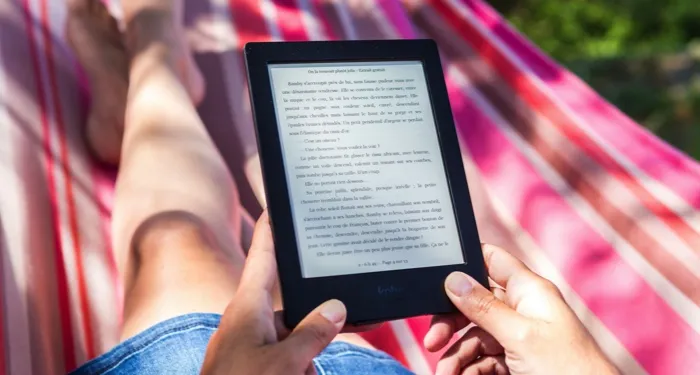How do you like to enjoy the stories you pick up? Do you strictly use printed books, opt for an ereader, absorb audiobooks streamed from your smartphone, or some combination of all three? Regardless of your reading preference, there’s an environmental cost attached to the production, distribution, and disposal of those books and ereaders. So, even though as a nation
Americans are recycling more than ever, taking measures to correctly and responsibly recycle your ereaders, tablets, and books is important.
Unfortunately print books and their digital counterparts are not indestructible, so it is likely that you’ll need to part with them eventually. This guide covers responsible methods for how to recycle your ereaders and digital tablets. If you’re looking for ways to part with printed books, check out
Book Riot’s information for recycling those.
The Importance of Responsibly Recycling E-Waste
We all understand that printing books require thousands of pounds of paper, but initiatives like the
Forest Stewardship Council, which encourages industries to use materials sourced from responsibly managed forests, and the
Environmental Paper Network that, among other things, encourages the use of recycled fibers over virgin paper, help make the production of new books much less damaging to the environment. Ereaders, on the other hand, cut down the use of paper required by book production, but are composed of metal, plastic, and glass components that are difficult to recycle and can be
hazardous to humans if not handled properly. These electronic equipment and materials that have reached the end of their use—called e-waste—are “the most rapidly increasing sources of waste worldwide (
source).”
So before we dive into the methods for recycling ereaders, I want to emphasize the importance of responsible e-waste disposal practices with an example. The ereader I bought in 2014 still works great, but someday the battery will putter out. If I were to toss that ereader into my trash can the day I can no longer resuscitate it with a battery charge, several bad things would happen: First, I would potentially be breaking the law or could accrue a fine based on my city of residence (
source). Second, once that ereader ends up in the landfill it would ooze toxic fumes and corrosive battery fluids into the air, waterways, and soil, directly contributing to environmental contamination (
source). (If you’re interested in learning about how e-waste damages the global population, visit the
World Health Organization’s website.)
Now that I’ve explained that horrible circumstance for you, I know you will never consider dumping your digital devices in the trash and instead want to learn about the correct disposal of e-waste. It’s good to know that there is no single correct way to recycle e-waste, and the options available to you vary based on where you live. This list includes resources that can either directly support the recycling of electronics or help you search for certified waste management initiatives.
Contact Your Local Waste Provider
Guidelines on what materials can and cannot be accepted for recycling varies by the U.S. state, county, or perhaps even city you reside.
RecycleNation’s State Guidelines gets you started with links to the waste management or environmental departments of each U.S. state (not territories). After accessing your state’s website, search for information on recycling and follow the agency’s guidelines. This may involve having to contact your community’s local waste management company, or you may find instructions for when, where, and how to dispose of e-waste and other materials.
The United States Environmental Protection Agency (EPA) also has a feature to search for recycling locations near you, and the website includes information about the appropriate steps to take when recycling or donating your ereader.
The Manufacturer May Recycle The Ereader For You
Fortunately, many producers of ereader devices recognize the importance of recycling rather than trashing their products. A few have taken charge of their own recycling programs or offer incentives to recycle their tech gadgets (and, in some cases, even products not made by them). Below are some basic explanations for manufacturers with information accessible on their websites about responsibly recycling their products:
Amazon Kindle and Tablets: Amazon has an Amazon Trade-In program that involves receiving a gift card to Amazon.com or a credit toward the purchase of a new device in exchange for an old one. The exchanged product does not have to be in usable condition to qualify. Another option is the Amazon Recycling Program, which you can apply for online to qualify and generate a prepaid UPS shipping label to begin the process of collection and recycling of your device.
Barnes & Noble NOOK and Tablets: Depending on the state you will recycle the ereader, Barnes & Noble may assist in the process. According to
their site, “In some states, Barnes & Noble participates in an electronic recycling take-back program managed by the Electronics Manufacturer’s Recycling Management Company, LLC, (MRM).” Visit their site or contact their support team to understand the procedure.
Samsung Tablets: Samsung has a few different “takeback options” for their products, which vary depending on where the consumer lives. For U.S. residents, Samsung has a
program through which you can get a postage-paid shipping label to mail in and recycle Samsung products only.
Apple iPad Tablets: For U.S. customers, Apple has a trade in program through which you can earn a credit for a new Apple product equal to the value of the device you want to part with. If Apple determines that the iPad or other product you want to exchange does not qualify for a trade, they can take it off your hands to recycle it.
Some Stores and Retailers Accept Electronic Recyclables
The EPA started a Sustainable Materials Management (SMM)
Electronics Challenge in 2012 with the goal to motivate “electronics manufacturers, brand owners and retailers to strive to send 100 percent of the used electronics they collect from the public, businesses and within their own organizations to third-party certified electronics refurbishers and recyclers.” Search the
List of Participants if you want the support of a retailer (where you may have bought your ereader from in the first place) when recycling your product. From there you’ll have to visit the participants’ websites to discover what the process of e-waste recycling involves (e.g. mail-in or store drop-off options)
If the Ereader is in Good Condition, Consider Making a Donation
If your reason for getting rid of an ereader is simply because you want to replace it with a newer model or you no longer have a use for it, consider donating it if the ereader is in good condition. Many
Goodwill locations accept and resell electronic and digital materials, and you will be giving your ereader a second life.
Search for the Goodwill donation center closest to you and visit their website or contact the center to confirm what items they accept before exchanging your responsibility to dispose of the ereader to them.
Notes About E-Waste Recycling
Some of these resources include explanatory statements that they will take the steps to delete all personal information from your ereaders before proceeding with the recycling or re-use (refurbishing, etc.) of it. Still, it’s a very good idea to take the initiative and wipe your electronic device of all data regardless of which organization you trust to recycle it.
Finally, the ongoing COVID-19 pandemic may affect when, how, and where you can recycle electronic and other products. Confirm that the organization you plan to work with for recycling is currently operating by checking their website and dialing their contact number, if available, for the most up-to-date guidelines on recycling procedures.
Recycling is a critical method for diverting e-waste from landfills and preventing environmental contamination, so you can feel good about doing your part when you follow these steps to recycle your ereader. If you’re inspired to learn more about environmental stewardship and nature in general, check out Book Riot’s lists of
books about the environment,
books for nature lovers,
children’s literature focusing on the environment, and books about
The Green New Deal.















